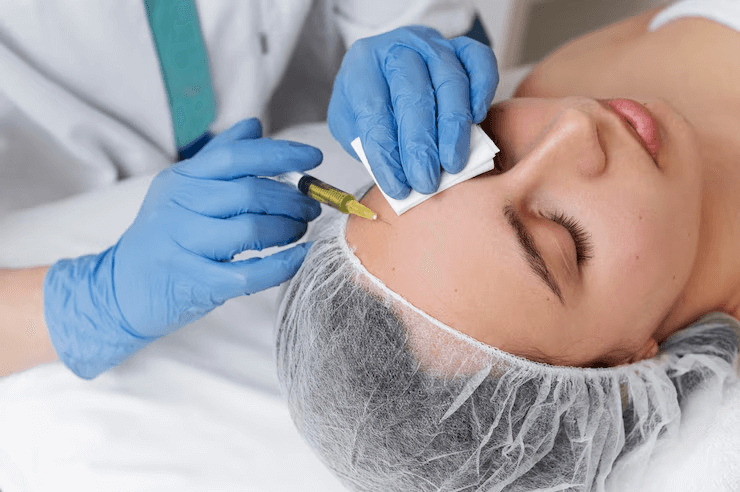PRP Hair Treatment
PRP refers to Platelet-Rich Plasma. It is a type of regenerative medicine that utilizes a concentration of the patient’s own platelets to stimulate healing in a targeted area. For hair loss, PRP is injected into the scalp where thinning of the hair has taken place in order to activate the hair follicles and cause new growth.
Platelets are amongst the constituents of blood, growth factors and protein-abundant substances that work on healing as well as on the regeneration of tissue.
Drawing out a quantity of the patient’s blood, concentrating the platelets through a processing method, and injecting back into the scalp, PRP deposits strong growth factors into the follicles

PRP Procedure Step-by-Step
Phase 1: Preparation & Consultation
1. Initial Consultation:
Medical History Review: Your doctor will review your medical history, medications you are currently taking (particularly blood thinners or NSAIDs), and allergies.
Assessment: They will assess the area to be treated and decide whether PRP is a good option for your condition.
Explanation of Procedure: The doctor will tell you about the PRP procedure, possible benefits, risks, side effects, and what you can expect.
Consent: You will be asked to sign a consent form.
Pre-Procedure Instructions: You may be instructed to: Avoid taking anti-inflammatory medications (such as ibuprofen, naproxen) and some supplements (such as fish oil, vitamin E) a week or two prior to the procedure, since these interfere with platelet activity. Drink well. Avoid smoking and alcohol.
phase 2: The Procedure (Generally takes 30-90 minutes)
Blood Draw:
A small volume of your own blood (about 10-60 mL, comparable to a routine blood test) is removed from a vein in your arm via a sterile collection tube and needle.
Centrifugation (Separation Process):
The drawn blood is poured into a specialized centrifuge device. The centrifuge spins the blood at extremely high rates of speed for some minutes (for example, 5-15 minutes). The process of the blood components is separated based on their density
Red Blood Cells (RBCs): Heaviest, gravitates to the bottom.
Platelet-Poor Plasma (PPP): Lightest plasma, floats on top.
Platelet-Rich Plasma (PRP) & Buffy Coat: A thick middle layer of concentrated platelets and white blood cells (leukocytes). This is the “liquid gold” to be utilized.
PRP Extraction & Preparation:
The practitioner then slowly extracts the PRP layer from the centrifuged sample via a sterile syringe. Occasionally, an “activator” (such as calcium chloride or thrombin) is mixed with the PRP immediately prior to injection to facilitate the release of growth factors from platelets, although this action is not uniform.
Site Preparation:
The site to be injected is carefully disinfected with an antiseptic cleanser (e.g., alcohol or chlorhexidine) to reduce the risk of infection. Depending on the area being treated and your pain threshold, a topical anesthetic cream, local anesthetic injection, or cooling spray may be used to make the injections more tolerable. This requires time to act (e.g., 20-30 minutes for topical cream).
PRP Injection:
With a fine sterile needle, the prepared PRP is slowly injected into the area being treated.
For joints/tendons: Considering the direct injections into the joint space or around the tendon, ultrasound guidance is commonly employed for precise application.
For scalp (hair loss): Small injections are placed in multiple points along the thinning scalp areas.
For skin rejuvenation (face): The PRP may be injected using micro-needling procedures or direct small injections in localized areas (e.g., under the eyes, nasolabial folds). The amount of injections and the amount injected vary depending on the condition as well as the area being treated.
Phase 3: Post-Procedure & Recovery
Immediate Post-Injection Care:
The treated area may be cleaned softly. A cold compress or an ice pack can be used to minimize swelling and discomfort. Occasionally a basic dressing is applied if there is some minor pinpoint bleeding.
Post-Procedure Instructions & Recovery:
You will get certain post-procedure instructions, which are usually: Resting from strenuous activity for a day or two (or more, depending on the location). Omitting anti-inflammatory drugs (NSAIDs) for a time (e.g., 1-2 weeks), as inflammation is a part of the healing process PRP will try to induce. Acetaminophen (Tylenol) is generally fine for pain. Washing the area. You can expect some tenderness, bruising, or swelling at the injection site(s) for a few days. This is normal. Results are not instantaneous. Time (weeks to months) is required for the growth factors to induce tissue repair and regeneration.
Follow-Up:
A follow-up visit can be arranged to monitor your progress. Most conditions need a course of PRP treatment (e.g., 2-3 visits, 4-6 weeks apart) for best effects.
Important Considerations:
Practitioner Skill: Success with PRP may be operator-dependent, depending upon the practitioner’s skill level and the PRP preparation system utilized.
Individual Variation: Responses to PRP vary from person to person.
Not a Cure-All: PRP is a promising therapy for many conditions but isn’t guaranteed to work for everyone or every condition.
Book Your Consultation Today!
Don’t let acne scars hold you back! Schedule a consultation at Sculpture Health Care and take the first step toward flawless skin.




